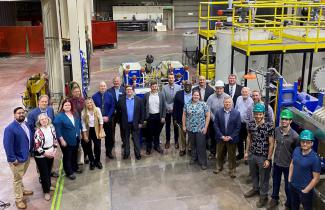NETL experts recently joined U.S. Department of Energy (DOE) Office of Fossil Energy and Carbon Management (FECM) leaders in North Dakota to learn about the development of technologies that can harness the state’s massive reserves of lignite coal to extract key rare earth elements (REEs) and critical minerals (CMs), which are needed to manufacture nearly all high-tech devices and are critical to the clean energy economy.
Assistant Secretary for FECM Brad Crabtree and Ryan Peay, deputy assistant secretary for FECM’s Office of Resource Sustainability, led the contingent, which included representatives from DOE’s Office of Manufacturing and Energy Supply Chains and Office of International Affairs as well as Brett Hakey and Jason Montgomery, federal project managers on NETL’s Minerals Sustainability Team, and Jessica Mullen, technology manager of NETL’s Critical Minerals and Materials Program.
The group visited the University of North Dakota’s rare earth element extraction pilot facility and the laboratories of Microbeam Technologies Inc., both located in Grand Forks. Members of the group also visited Falkirk Mining Company, a subsidiary of North American Coal Company and operator of the Falkirk Mine near Underwood, North Dakota. According to the U.S. Energy Information Administration, the Falkirk Mine produces nearly 8 million tons of lignite annually.
In addition to everyday technologies such as cellphones and electric vehicles, REEs and CMs are essential to national security and clean energy technologies. Wind turbines, for instance, need strong magnets built with REEs. As the nation transitions to a clean energy future, REE and CM demand will continue to rise.
Foreign suppliers currently dominate the REE and CM markets, making the development of a reliable domestic supply chain of REEs and CMs a top U.S. priority. Furthermore, the International Energy Agency has estimated that demand for REEs and CMs will at least quadruple by 2040.
“One of the highlights of the project site visits was learning in great detail about the innovative process that is being developed in North Dakota to extract germanium and gallium from lignite,” Hakey said.
Germanium and gallium are CMs needed to manufacture electronics, including semiconductors, which are an essential component of devices used in energy, communications, health care, transportation and defense industries.
According to the North Dakota Geological Survey, Western North Dakota contains an estimated 351 billion tons of lignite, the single largest deposit of lignite known in the world. Although it has been used primarily as a fuel to generate electricity, the state’s lignite is also an excellent potential source of REEs and CMs.
The DOE partners in North Dakota are advancing the use of a solvent to extract the REEs and CMs from lignite feedstock. The goal is to minimize the environmental impact of the process by reducing water usage, recycling water and responsibly disposing of wastewater and solid wastes. So far, this work has shown tremendous potential for success.
In addition to removing germanium, gallium and other REEs, the extraction process upgrades the lignite into a unique carbon product that can be a better fuel or used in an array of carbon-based products such as graphene and graphite to make battery anodes.
“Getting to see the extraction process first-hand was invaluable because it enables DOE-NETL to better understand and advance this technology that could provide coal-producing regions of North Dakota with new avenues for economic growth as the nation transitions to a clean energy economy,” Hakey said. “In the future, North Dakota could very well provide a significant portion of our nation’s demand for germanium and gallium, so it was important for us to complete these project site visits to ensure that these projects stay on track and on schedule.”
“For decades, North Dakota lignite has generated electricity for the Northern Plains region. These projects, now underway with DOE’s support, have the potential to advance innovative, value-added uses for this traditional resource that can help power the clean energy and industrial economy of the future by providing vital minerals and materials for U.S. manufacturers while creating high-wage jobs for American workers,” Crabtree said.
NETL is a U.S. Department of Energy national laboratory that drives innovation and delivers technological solutions for an environmentally sustainable and prosperous energy future. By leveraging its world-class talent and research facilities, NETL is ensuring affordable, abundant and reliable energy that drives a robust economy and national security, while developing technologies to manage carbon across the full life cycle, enabling environmental sustainability for all Americans.




